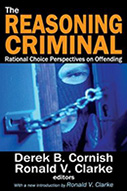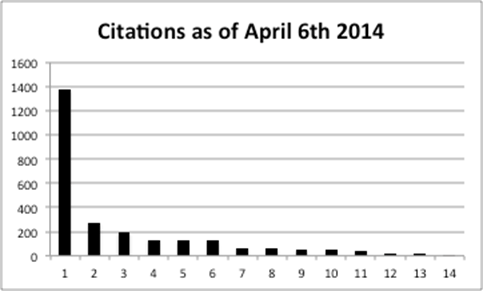The Reasoning Criminal: Rational Choice Perspectives on Offending

Editors: Derek B, Cornish and Ronald V. Clarke
Publisher: New Brunswick, NJ; London: Transaction Publishers, 2014. 268p.
Reviewer: Nick Tilley | July 2014
This book is a reprint of Cornish and Clarke’s classic 1986 collection, which was originally published by Springer-Verlag. The only change is the addition of an eight-page introduction, by Clarke.
The new introduction is, however, important. It reminds the reader how radical a departure from conventional thinking rational choice represented when it was first advocated as a framework for criminology. First, it concerned criminal behaviors and their situational contingencies, not just inclinations to commit crime. Second, it aimed to contribute to policy thinking about crime prevention, which was eschewed in much other criminology. Third, it was deemed a good enough, self-evident theory that could act as a guide for policy. It was not construed as a full-fledged and testable theory. Fourth, it emphasized the need to focus on specific forms of crime, rather than ‘crime’ or ‘delinquency’ in the abstract. Fifth, it stressed crime prevention rather than general social reform as the proper focus for criminology, accepting that crimes follow choices. This was not taken to mean that prevention is best achieved through punishment for making those choices. Rather the situational contingencies involved in making choices formed a fruitful point of intervention. Finally, it did not make a hard distinction between offenders and non-offenders. All are situated decision-makers whose circumstances might provide opportunities and temptations sometimes to commit crimes. Clarke’s introduction also concedes that rational choice theory will need to develop in the next few years to take account of criticisms arguing that greater attention needs to be paid to situations producing non-rational, emotional and visceral aspects of specific criminal choices.
The new edition is very welcome not just for the introduction. It is also much cheaper and more readily available than the old, which has, as Clarke remarks in his introduction, been widely cited.
The figure below shows the number of citations, according to Google Scholar, up to April 6th 2014. The column to the left refers to citations to the book as a whole. There then follow those for individual chapters. The total for the individual chapters (1168) falls a little below that for book itself (1379).

The most highly cited individual chapter is by Marcus Felson (277). This is characteristically brilliant and alone worth the price of the book. Its opening sentence, intentionally or otherwise echoing but bettering Marx’s famous aphorism that men make history but not in conditions of the own choosing, should be hard-wired into all social scientists. It goes, ‘People make choices, but they cannot choose the choices open to them.’ Felson goes on to say that choices once made produce chains of events that those making them cannot predict. In other words there are unintended and unanticipated consequences. Moreover, the choices open to us are often unintended consequences of others’ actions. For example the unintended consequence of a decision to leave a window open when going to pick children up from school comprises an opportunity for a passer-by to choose to climb in and steal goods. It is also in this chapter that Felson introduces his influential notion of the ‘intimate handler’ as a prospective controller of offenders. Here, disapprobation of the misdeeds of the known other rather than guardianship of prospective targets can effectively go between a likely offender and a suitable target of crime.
The theme of situated choice runs through Felson’s chapter and also through the whole collection. The title of the book suggests that criminals reason and that their choices are rational. The text stresses that offenders’ rationality is circumscribed, weak, or bounded. The individual chapters based on empirical research are replete with demonstrations that offenders often fail fully to act rationally: novice shoplifters worry about ethics; luck and fatalism are found amongst robbers; robbers also are apt to act spontaneously; desistance follows shock; and opioid takers give up as they tire of the lives they have been living. The more theoretical chapters highlight external causes (rather than choices) over involvement in offending; acknowledging blundering amongst offenders; emphasizing departures from simple expected utility as a condition for criminal choices; focusing on the role of internalized norms in shaping behavior; noting that offenders have a rather limited capacity to process information rationally as a basis for their decisions; raising the possibility that ‘risk (and danger) compensation’ may complicate adaptation to increases in the expected costs (and risks) of some criminal behaviours; and commenting that rational choice may over-emphasize the degree to which offending follows choices made by individuals alone and for which they can therefore be held accountable.
Hence, as a collection The Reasoning Criminal was and is no simple-minded tract peddling a view that offenders are rational, instrumental decision-makers who coldly and conscientiously calculate expected costs, risks and rewards following from one behavior or another in order to do whatever will best meet their instrumental needs. The work of Kahneman and Tversky is widely drawn on, emphasizing common sources of cognitive error and bias, as is that of Simon stressing limited or bounded rationality.
Unfortunately, The Reasoning Criminal appears often to be treated as if it were promulgating a mechanical account of the offender as a simple and competent rational utility-estimator and utility-maximizer. Critics, however, highlight the implausibility of this assumption. Moreover, it has been all too easy for sympathizers to teach students and practitioners that this is the case, in part because there are plenty of examples where changes have been made to conditions that alter risks, effort and reward that have been associated with reductions in specific offences. Friends and foes alike are apt to resort to simplifications to suit their rhetorical purposes. I suspect that many of those citing the book had read little or none of it. They have referred to it as a source for the authoritative statements they (mistakenly) assume it makes! The cause of the problem may be that the original edition was costly or unavailable. The new edition ought to lead to more reading and fewer assumptions.
Cornish and Clarke, alongside (almost all of the) contributors to their collection, are in very good company in a) emphasizing the heuristic and analytic value of rational choice as a starting point in trying to understand human behavior, while b) acknowledging that in practice rationality routinely appears to be compromised, and therefore, c) making the source and nature of such departures from apparent full rationality a key focus for research. Max Weber and Karl Popper both basically adopted a position closely akin to this. It has been a cornerstone of classical economics. Even anthropologists such as Marcel Mauss draw on bounded rational choice to explain some apparently altruistic behaviors, for example in his work on gift-exchange and its consequences for social solidarity. Max Weber refers to affect and values in his theory of action as well as instrumental rationality, albeit that the explanatory starting point is the latter. Contemporary analytical sociology adopts a similar orientation. The anticipated refinements to the theory, embracing the departures from rationality and incorporating more fully the routine operation of situational contingencies that work through non-rational mechanisms affecting criminal choices will be a major theoretical challenge for criminology and crime science in the coming decade.
What might these developments look like? How might they be expressed? The developments in the classification of situational crime prevention comprise at least a tacit recognition that more than rationality is at work in choices to commit (and not to commit) crime. The first iterations of the classificatory framework included headings only for risk, effort and reward. These all clearly speak to instrumental rationality and utility maximization. A later iteration referred to inducing guilt or shame, indicating that situational contingencies relating to moral reasoning may also affect behavior. Finally, provocation reduction was added as a fifth heading, recognizing that affect plays a part in human choice-making. These additions to the situational crime prevention repertoire, combined with the sources of boundedness to rational choice already acknowledged in The Reasoning Criminal, suggest some specific directions for theory-building and research.
Notwithstanding the need for theoretical refinement, there will likely continue to be strong benefits in retaining rational choice theory as a key foundation for criminological research and for trying to find points of intervention to prevent crime. First, most decisions can be assumed to reflect least a modicum of rationality on the part of the individual offender. People choose to commit a particular crime because doing so appears to yield them at least some utility over and above non-commission of the crime, even if there are other types of reasoning also at work in their decisions. Second, with regard to policy and practice, situations giving rise to decisions to commit crime can be looked at for pinch-points to alter the balance of expected costs and benefits in favor of non-commission of crime.
But it is becoming increasingly apparent, both from the chapters contained in the reasoning criminal and in more recent work in behavioral economics and evolutionary psychology, that rational choice needs to be supplemented both better to capture the situations surrounding choices to commit (or not to commit) crime and to broaden the repertoire of preventive options. Some of this need for supplementation relates to reasoning that is non-rational. It was only the sub-title to The Reasoning Criminal that refers to ‘Rational Choice Perspectives’, but reasoning (having reasons for) actions extends beyond ‘rational choice’, at least as that phrase has come to be understood in economics. My reasons for offending or non-offending may refer to moral considerations: I killed (or did not kill) that person because they deserved to die (or live). Equally my reasons for offending may refer to my feelings. I killed that person because I hated or was envious of or resented them and wanted them dead. It is likely that my reasoning will generally be a mix of feelings, morals and rational choice: I hate (feelings) that person because s/he betrayed my country (moral justification) and did so covertly so I wouldn’t be easily caught (rational choice). I may try to reduce the temptation to kill that person by moving so far away that I’m unlikely to come across him in my day-to-day routines (removing both opportunity and the provocation that I would experience on seeing him). In this way I overcome the cognitive dissonance I experience on seeing him and wanting to see him dead and believing that he deserves to die, whilst believing that it is proper to obey the law and that the law quite properly prohibits murder. However, if I come across the man I’d like to kill and have previously been primed to act accordingly, say by hearing vivid details of the consequences of his betrayal, this reinforces my hatred and belief that his murder is warranted and if I happen to have a handgun with me, I become more likely to kill him.
These highly recognizable forms of the complex reasoning involved in individual acts have their rough counterparts at an aggregate level, for example in the case of participation in genocide, honor killings, racist attacks and mob murders. What is at stake in going beyond rational choice is not captured simply by referring to ‘bounded rationality’. Rationality is indeed bounded, of course, by the lack of time, information or ability to work out consequences, by the practical need for rules of thumb in decision-making, and by the habits of thought highlighted by Kahneman and Tversky. These limitations in our rationality operate behind our backs and can inhibit accurate utility-calculation and choices of behavior to achieve this. More than this, though, some forms of reasoning that lie behind decisions refer to different orders of thought relating to ethics and emotions, which are not oriented to utility maximization.
I rather hope that the reprinting of this volume will stimulate new efforts to go beyond rational choice but without losing the novel insights that followed from its development and the practical help it has provided in thinking through practical preventive strategies. This largely accords with Clarke’s own conclusion at the end of his introduction to the second edition, ‘that within the next few years the RCP will develop into a more complete and satisfying theory…’ (p.xv).
Nick Tilley, University College London

